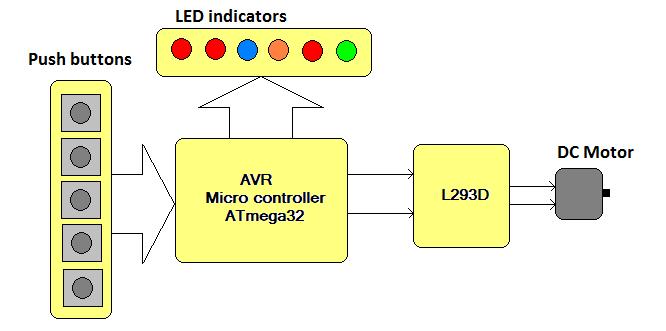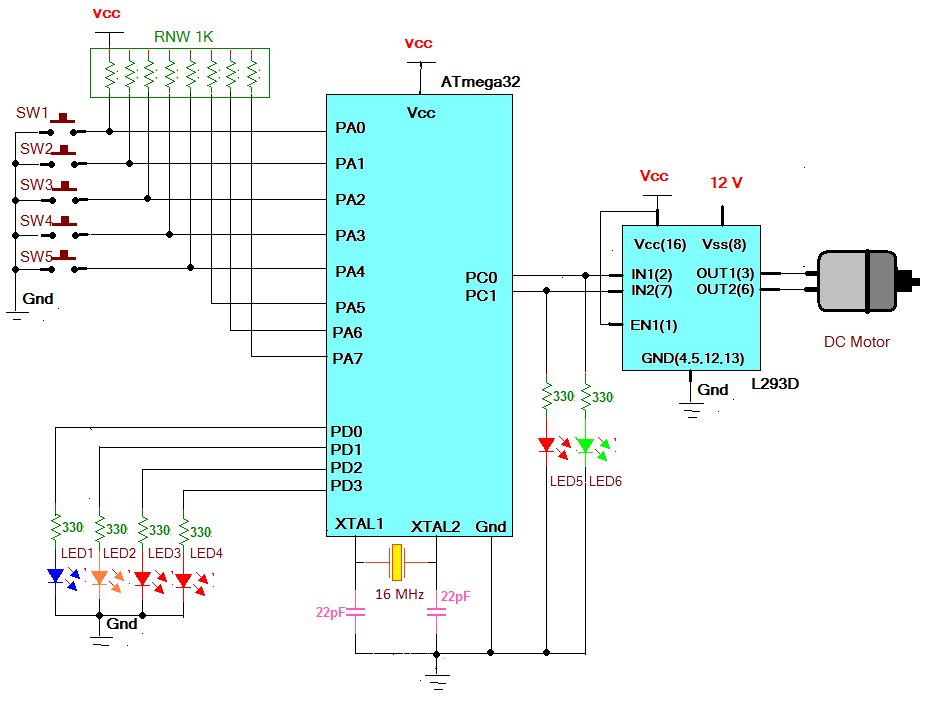Controlling direction and speed of DC motor is very essential in many applications like
· Robotic application – to change direction and speed of moving robot
· Industrial application – to change direction and speed of rotating machinery
· Domestic application – to vary speed of battery (DC) operated portable fan
· Defence application – to rotate radar, automatic gun, tank gun in either direction
· Communication application – rotate dish antenna upward – downward or clockwise – anticlockwise
Thus we can count number of such applications where there is a need to change direction and/or speed of DC motor. The direction of DC motor can be controlled by just reversing the polarity of given supply. And for varying speed, there are various ways to vary speed of DC motor but the best amongst them is PWM – pulse width modulation technique. In this technique we shall vary the width of applied pulse that will vary average voltage applied to motor and its speed will change.
So this project demonstrates how to vary the speed and change the direction of simple 12V 500 RPM DC series motor using AVR microcontroller ATmega32.
System block diagram: –

Fig. 1: Block Diagram of AVR ATMega32 based DC Motor Controller
The major building blocks of this system are as shown in figure that are ATmega32 and DC motor driver chip L293D. Along with them we need some push buttons for controlling and LEDs for indications. Each block is described briefly here.
Push buttons – five push buttons are given to run, stop, change speed and direction of DC motor
|
Button |
Function |
|
Button 1 |
Run motor in clockwise direction |
|
Button 2 |
Run motor in anticlockwise direction |
|
Button 3 |
Stop motor |
|
Button 4 |
Increase speed |
|
Button 5 |
Decrease speed |
L293D chip – this chip takes input from micro controller and drives DC motor. The micro controller output current is not enough to drive DC motor directly. The chip has quad half H bridge drivers. It will provide up to 600 mA current to motor that is enough to drive it.
LED indications – six LEDs are used for different indications
|
LED |
colour |
indication |
|
LED 1 |
red |
Blinks when motor runs in clockwise direction |
|
LED 2 |
green |
Blinks when motor runs in anticlockwise direction |
|
LED 3 |
Blue |
Blinks when speed in increased |
|
LED 4 |
Orange |
Blinks when speed is decreased |
|
LED 5 |
red |
Lits ON when speed limit is maximum |
|
LED 6 |
red |
Lits ON when speed limit is minimum |
· Scans push buttons continuously to get user input
· Give different indications on LEDs
· Run or stop DC motor
· Change direction or speed of motor
The circuit is made up of ATmega32, L293D and few discrete components like LEDs, registers, capacitors, push buttons etc
· 5 push buttons SW1 – SW5 are connected to PORTA pins PA0 to PA4. Also all port pins are pulled high through external pull up resistors as shown
· 4 LEDs LED1 – LED4 are connected to PORTD pins PD0 to PD3 through current limiting resistors
· PORTC pins PC0 and PC1 are connected to input of L293D chip. 2 LEDs LED5 and LED6 are also connected to these pins through current limiting resistors
· DC motor is connected to output of L293D chip
· A 16 MHZ crystal with two 22 pF capacitor is connected to crystal input pins XTAL1 & XTAL2
· Vcc supply of 5 V is connected to required pins of both chips and pull up resistors
· Additional 12 V supply is given to L293D chip for motor only
Working & Programming
System working and operation: –
· Initially motor is stop. All the LEDs are OFF
· When SW1 is pressed momentarily, the motor starts rotating in clockwise direction. The green LED blinks at rate of PWM frequency
· Now if SW4 or SW5 button is pressed, the motor speed will increase or decrease. It is indicated by blink of LED1 or LED2
· If anyone keep on pressing SW4 or SW5 then speed will keep on increasing or decreasing. When max or min limit is reached, the corresponding LED3 or LED5 will be ON
· While motor is running in clockwise direction if SW2 is pressed, the motor will immediately start rotating in anticlockwise direction and vice versa
· Pressing SW3 will stop running motor
Program: –
AVR microcontrollers have built in feature to generate PWM using internal timer. We can use this feature to generate PWM and vary speed of DC motor. But such type of feature is not available in all micro controllers so in that case we have to generate PWM using program. So here i am not using inbuilt feature but generating PWM using program. Program is written in C language. Its compiled and simulated using AVR studio software. Complete program is made up of different functions
· Keydly() function – this function generates key debounce delay of approx 0.2 sec that is required when key is pressed
· Incspeed() function – this function increases width of pulse fed to motor by increasing ON time and decreasing OFF time. It also checks for maximum speed limit. If maximum speed limit is reached it turns ON LED3
· decspeed() function – this function decreases width of pulse fed to motor by decreasing ON time and increasing OFF time. It also checks for minimum speed limit. If minimum speed limit is reached it turns ON LED4
· clockwise() function – it continuously gives PWM to motor to rotate it in clockwise direction till any button is not pressed
· anticlockwise() function – it continuously gives PWM to motor to rotate it in anticlockwise direction till any button is not pressed
· main() function – it initializes ports as input or output and then it scans all the buttons in continuous loop.
Project Source Code
### #include <avr/io.h> #include <util/delay.h> uint16_t ton=5000,toff=5000; void keydly() // key debounce delay { uint8_t i; for(i=0;i<7;i++) _delay_loop_2(10000); // delay loop library function } void incspeed() // increase width of pulse { PORTD = (0<<PD3); // led indication if(toff>1000) // check for minimum off time { toff=toff-500; // if not then decrease off time ton=ton+500; // and increase on time } if(toff==1000) PORTD = (1<<PD2); // if max limit is reached - LED on } void decspeed() // decrease width of pulse { PORTD = (0<<PD2); // led indication if(ton>1000) // check for minimum on time { toff=toff+500; // if not then increase off time ton=ton-500; // and decrease on time } if(ton==1000) PORTD = (1<<PD3); // if min limit is reached – LED off } void clockwise() // rotate motor clockwise { while(PINA==0xFF) // till any key is not pressed { PORTC=0x01; // apply PWM to motor _delay_loop_2(ton); PORTC=0x00; _delay_loop_2(toff); } } void anticlockwise() // rotate motor anticlockwise { while(PINA==0xFF) // till any key is not pressed { PORTC=0x02; // apply PWM to motor _delay_loop_2(ton); PORTC=0x00; _delay_loop_2(toff); } } int main(void) { uint8_t r=0,d; // run and direction flag DDRC=0x03; // initialize ports as input and output DDRD=0x0F; DDRA=0x00; PORTC=0x00; PORTD=0x00; while(PINA==0xFF); //wait till any key is pressed loop:switch(PINA) { case 0xFE: // for 1st key keydly(); r=1; // set run flag d=0; clear direction flag for CLK direction clockwise(); // start rotating motor clockwise break; case 0xFD: // for 2nd key keydly(); r=1; // set run flag d=1; // set direction flag for ACLK direction anticlockwise(); // start rotating motor anticlockwise break; case 0xFB: // for 3rd key PORTC = 0x00; // stop motor PORTD = 0x00; // all indications off r = 0; // clear run flag Break; case 0xF7: // for 4th key PORTD=(1<<PD0); // blink LED1 keydly(); PORTD=(0<<PD0); incspeed(); // increase speed if(r==1) // if motor was running { if(d==0) clockwise(); // keep it running clockwise else anticlockwise(); // or anticlockwise } break; case 0xEF: // for 5th key PORTD=(1<<PD1); // blink LED2 keydly(); PORTD=(1<<PD1); decspeed(); // decrease speed if(r==1) // if motor was running { if(d==0) clockwise(); // keep it running else anticlockwise(); } break; } goto loop; } ###
Circuit Diagrams
Project Video
Filed Under: Electronic Projects
Filed Under: Electronic Projects



Questions related to this article?
👉Ask and discuss on Electro-Tech-Online.com and EDAboard.com forums.
Tell Us What You Think!!
You must be logged in to post a comment.